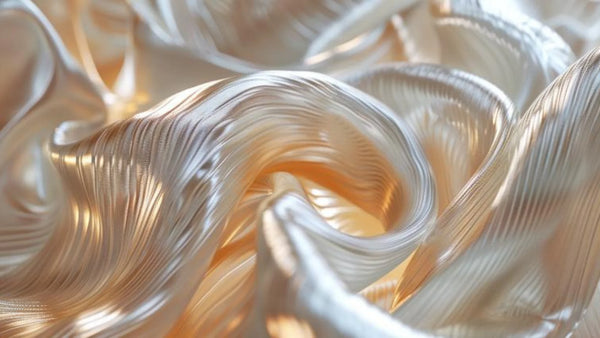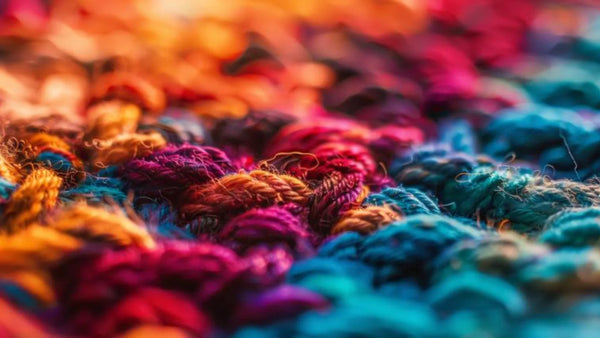Key Takeaways
- polyester is a synthetic fiber derived from petroleum, strong and durable.
- Its main qualities are its resistance, its crease resistance, its lightness and its easy maintenance.
- Widely used in the textile industry for clothing, household linen, swimwear, etc.
The Oversized Hoodie® is THE French brand 🇫🇷 specialist in cocooning recognized for its high quality products certified Oeko-Tex® Standard 100 , non-toxic, non-chemical, 100% vegan and cruelty-free. Among our products, a large number have been awarded the international quality label "Confiance Textile", for their manufacturing quality, which is highly appreciated by our customers.
Understanding polyester: definition and origins
polyester designates a set of synthetic polymers containing the ester group in their main chain. This textile fiber was discovered in 1941 by English chemists. Derived from oil, its industrial production began in the 1950s in the United States.
Polyester: composition of a synthetic material derived from petroleum
The polyester fiber is obtained by a chemical process reacting two compounds from oil: terephthalic acid and ethylene glycol . This polycondensation forms a resin which is then stretched to create polyester threads, themselves used in the production of polyester fabrics.
- 60.5 M tonnes of polyester produced in 2021: polyester is the most produced fiber. [Source]
- 26% of global greenhouse gas emissions if current trends continue: the textile industry is a major contributor to greenhouse gas emissions. [Source]
- 3e sector that uses the most water after wheat and rice: textiles are a very water-intensive sector. [Source]

Also read: Polyester and Pilling
The characteristics of polyester: strong points and disadvantages
Strength and elasticity of polyester: advantages for the textile industry
Thanks to its resistance to friction, chemicals and humidity, polyester is ideal for making durable clothing. Its flexibility and elasticity also offer excellent comfort.
Polyester and perspiration: a dilemma for sportswear
While polyester wicks away perspiration well, it tends to capture body odors. A mixture with other fibers such as cotton makes it possible to overcome this defect for sports clothing. Some brands also offer anti-odor treatments on polyester fabrics.
At The Oversized Hoodie®, we have developed sweatshirts in polyester mixed with other materials to combine breathability and quick drying. A perfect fiber blend for sportswear in our experience.
— Geoffrey, Founder of The Oversized Hoodie®
Uses of Polyester fiber
Polyester in the textile industry: various applications
polyester is omnipresent in our wardrobe: shirts, pants, dresses, jackets, swimsuits, household linens, etc. Its qualities make it a material of choice for ready-to-wear and technical clothing.
As an urban clothing brand, we have chosen to integrate polyester into many pieces of our collection. This synthetic fiber offers excellent value for money with its resistance, ease of maintenance and wrinkle resistance, ideal for everyday use.
— Geoffrey, Founder of The Oversized Hoodie®
Industrial Applications
Beyond textile, polyester is used to manufacture plastic bottles, body parts, carpets, carpets, curtains, canvas... Its mechanical and chemical properties make it a polymer widely used in the 'industry.
Polyester in Sport and Leisure
Thanks to its breathability, its quick drying and its lightness, polyester is ideal for sports clothing. sport and equipment for outdoor activities. It is also found in swimsuits, tents and sleeping bags.

Comparison of polyester with other materials
Polyester or cotton ?
cotton is a natural fiber more breathable than synthetic polyester. But the latter is more resistant, crease-resistant and easy to maintain. A mixture of the two allows them to combine their respective qualities.
cotton absorbs perspiration better and remains softer to the touch than polyester. However, polyester dries faster, does not shrink in washing and generally does not require ironing. clothing mixing cotton and polyester therefore combines comfort and practicality.
Also read: Polyester or cotton ?
Polyester or polyamide ?
polyamide (nylon) is another synthetic fiber very elastic and resistant, used for lingerie, tights or sportswear. polyester is less expensive and more durable.
Although polyamide is more extensible, polyester offers better holding over time. It is also easy to maintain than nylon which tends to pillingr. The choice therefore depends on the use: stretch for polyamide, strength for polyester.

Also read: Polyester or polyamide ?
Polyester or nylon ?
Even though they are often confused, nylon and polyester are two different polymers. Nylon is more elastic while polyester is more resistant to friction.
nylon has a more silky feel than polyester, which is considered more rough. But polyester is stronger, wrinkle-resistant and better withstands frequent washing. Each material therefore has its advantages depending on the intended use.
Polyester or wool ?
wool is a natural fiber that is warmer and breathable than polyester. But the latter is much more easy to maintain, crease-resistant and resistant to wear.
Unlike wool which can felt and shrink, polyester keeps its shape after repeated washing. It is also lighter, more insulating and is not afraid of moths. A practical choice for outerwear.

At The Oversized Hoodie®, we have received a lot of positive feedback from satisfied customers with our Oeko-Tex certified polyester plaid sweatshirts®.
A little before Christmas last year, a customer told us they loved the comfort and breathability of their Hoodie Blanket during relaxing evenings with family.
He also appreciated the softness and the warmth of the sherpa fabric which allowed him to stay warm. A winning blend of fibers to combine comfort, softness and well-being!
What are the common synthetic clothes in ready-to-wear ?
Polyester pants
Many pants for men and women contain polyester, either pure or blended with other fibers. This gives them comfort, crease resistance and durability.
Whether for city pants, suit pants or sports pants, polyester provides stretch, ease of maintenance and preservation of shape. An asset in fashion for everyday clothing.
Polyester dress
The dresses in polyester are light, breathable and do not wrinkle. An ideal choice for summer outfits or elegant evening dresses.
Thanks to its fluidity and its crease resistance, polyester hangs well and requires little or no ironing. Perfect for chic dresses that need to keep a beautiful hang.
Polyester sweater
The sweaters in polyester or with a percentage of this fiber are soft, warm and easy to maintain. Perfect for outerwear.
Whether it's a fine sweater, a large knit sweater or a fleece sweater, polyester ensures comfort, insulation and simplified maintenance. Ideal for sweaters to put on without worry.
Polyester jacket
Whether for a suit jacket, a fleece jacket or a jacket, polyester provides resistance and waterproofing to outerwear.
Thanks to its technical properties, polyester makes it possible to create warm, windproof and water-repellent jackets. A material of choice for durable outdoor clothing.
Polyester shirt
shirts with polyester do not wrinkle and dry quickly. An asset for work shirts or travel shirts.
Whether it's a plain shirt, a checked shirt or a dress shirt, the addition of polyester makes ironing and drying. Practical on a daily basis.

Also read: How to remove stains from polyester ?
Polyester manufacturing: process and environmental impact
Water and energy consumption in the manufacture of polyester
The production of polyester consumes a lot of water and fossil energy (oil). It is estimated that it takes 100 liters of water and 3 kg of oil to manufacture 1 kg of polyester: therefore a significant impact on the environment.
CO2 emissions and toxic vapors in polyester production
The polyester industry releases greenhouse gases (called CO2) and toxic chemical compounds into the air and water. Its carbon and environmental balance sheet is therefore very negative.
Recycling polyester: is it possible ?
Yes, polyester is a recyclable material. plastic bottles or used clothing can be recovered to produce new recycled polyester threads. This saves resources.
How to maintain polyester ?
How to wash polyester ?
polyester withstands high temperature washing (60°C) and classic laundry detergents very well. Just avoid chlorinated products which can damage it. A cold wash is often sufficient.
You can wash your polyester clothes in the machine without problem. Use a delicate program or a short spin to avoid excessive creasing the fabrics. Polyester is a strong fiber that retains its shape.
How to dry polyester
polyester dries very quickly after washing. You can tumble dry without problem or air dry. Just avoid too high temperatures.
Thanks to its rapid moisture evacuation capacity, polyester does not retain water. So you can hang it out or put it in the tumble dryer at low temperature. A great advantage for efficient drying.
How to iron polyester ?
Thanks to its crease resistance, polyester generally requires no ironing. If necessary, use a iron at medium temperature and steam.
Most polyester clothing maintains a beautiful hang naturally after washing. But you can always iron lightly with a iron for an impeccable finish.

Also read: How to Effectively Remove Wrinkle from Polyester Clothing ?
Conclusion
polyester is an essential synthetic fiber with many advantages: resistance, crease resistance, easy maintenance, quick drying, etc. Its applications are numerous in textiles, but also furniture, sport or industry . Despite some flaws such as its limited perspiration, polyester remains a material of choice for creating clothing and durable and efficient.
objects| Characteristic | Advantages | Disadvantages | Applications |
|---|---|---|---|
| Resistance and durability | Ideal for durable clothing, resists friction and humidity | Can capture body odor | Clothing, household linen, sports equipment |
| Ease of maintenance | Frequent washing at high temperature without deformation, wrinkle resistant | Can generate static electricity | Ready-to-wear, technical clothing |
| Ecological | Recyclable, saves resources | Production consumes a lot of water and energy, CO2 emissions | Plastic bottles, recycled fibers |
| Comfort and aesthetics | Flexibility, elasticity, quick drying | Less breathable than natural fibers | Sportswear, summer outfits, evening dresses |
FAQ
Is polyester a good material ?
Yes, polyester is an excellent fiber with many qualities: resistance, crease resistance, ease of maintenance, longevity, etc. It is a material of choice for many uses.
Does 100% polyester keep you warm ?
Yes, 100% polyester is a rather warm fiber. It is more insulating than cotton but less than wool. A mixture with other materials makes it possible to obtain a warm garment.
Is polyester plastic ?
Yes, polyester is a type of plastic obtained by polycondensation of molecules derived from petroleum. It is therefore a synthetic polymer such as polyethylene or PVC.
What is the difference between cotton and polyester ?
The main advantage of polyester over cotton is its great resistance and easy maintenance .But cotton remains more breathable, soft and natural.
How to machine wash 100% polyester ?
You can wash 100% polyester clothing in the machine at 60°C maximum with classic detergent. Avoid chlorinated products and too high temperatures.
Polyester or polypropylene carpet ?
polyester and polypropylene are two synthetic fibers used for rugs and carpets. polyester is more resistant while polypropylene is more insulating.
Is polyester dangerous for the skin ?
No, polyester is generally not dangerous for healthy skin. However, some people may develop allergic reactions to chemical components used in the manufacture of polyester. The risk is higher with new clothing which releases more particles.
recycled polyester from plastic bottles presents fewer risks than virgin polyester. In addition, Oeko-Tex standards certify the safety of polyester fabrics for the skin. Rinse new clothes well before wearing.
Oeko-Tex certified synthetic clothing: what does that mean ?
Oeko-Tex is a certification which guarantees the absence of toxic substances in textiles. To be labeled, a garment made of polyester or another synthetic fiber must meet very strict thresholds.
This standard reassures about the harmlessness of clothing for the skin and the environment. It limits CO2 emissions, discharges in sewage treatment plants and the use of harmful chemicals during production . A guarantee of quality for the tons of polyester manufactured each year.
References
[1] "Polyester", Wikipedia
[2] "Polyester: advantages and disadvantages of this synthetic material - Definition", Marques de France
[3] "Polyester: everything you need to know about this controversial material", Journal des Femmes
[4] "9 Uses Of Polyester and Their Differences", Xometry






